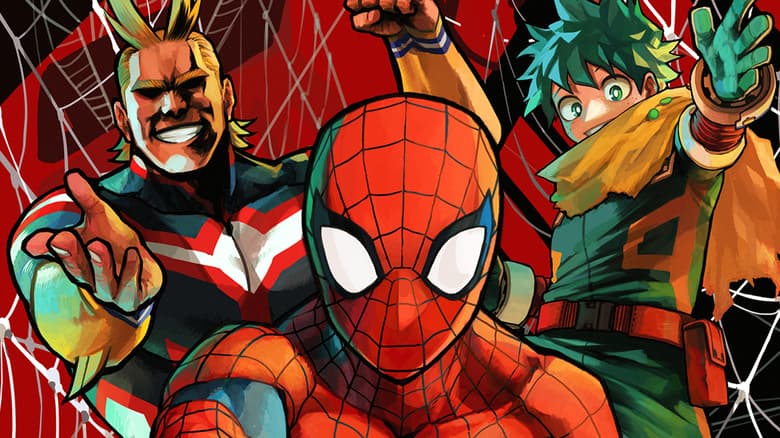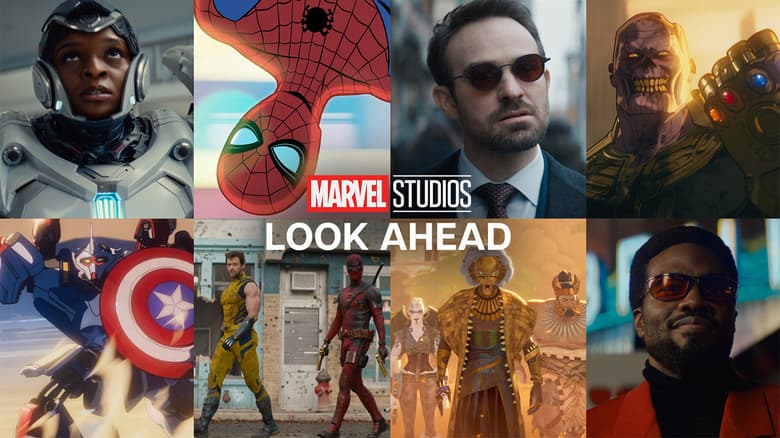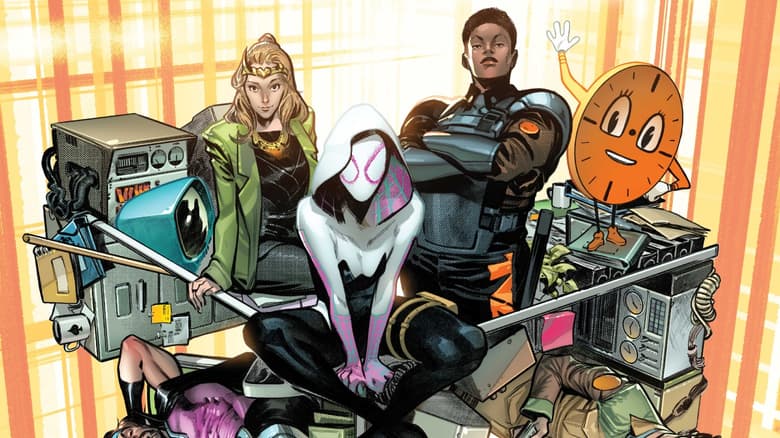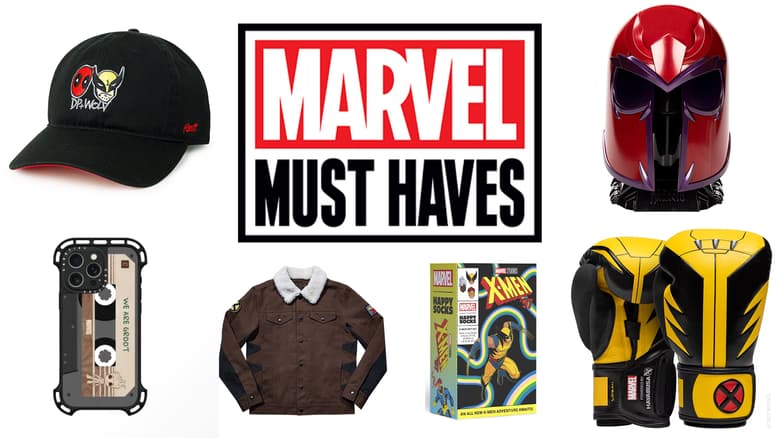The Great Guardians Retrospective Pt. 1
Marvel’s Bill Rosemann dives deep on birthing the Guardians of the Galaxy!
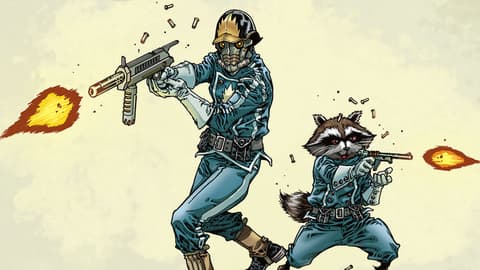
It might sound crazy right now, but if you time traveled back a full decade and told a comic-loving audience that the Guardians of the Galaxy would be a mega Marvel franchise in the same vein as the Avengers, you would have been laughed back through the timestream. At that point, the team that has now starred in several comic book series as well as a major motion picture with a sequel hitting on May 5, a Disney XD cartoon, multiple action figure lines, and the upcoming Telltale video game series, didn’t exist yet.
Sure, the original team had a nice run and Peter Quill had started making a name for himself in the original ANNIHILATION series as Nova’s main strategist, but the first embers of the Guardians fire started to flame in the pages of 2007’s ANNIHILATION: CONQUEST – STAR-LORD by writer Keith Giffen and artist Timothy Green II. In that book, Quill returned to his super hero identity and led a ragtag group including Rocket Raccoon, Groot, Bug, Deathcry, Mantis, and Captain Universe on an important mission. Not everyone survived, but by the end of the main ANNIHILATION: CONQUEST story, a team sure seemed like a good idea.
That of course finally came in 2008 with GUARDIANS OF THE GALAXY written by Dan Abnett and Andy Lanning. But even before all the writers, artists, and fans got involved in the story, one person saw the value in these characters and wanted them to succeed. That person was then-editor Bill Rosemann and this is his story of co-creating the Guardians of the Galaxy as we know them today.
Marvel.com: How did you get involved in the Marvel Cosmic books?
Bill Rosemann: What happened was I was at the distinguished competition when Annihilation was happening and I was reading it. I was loving it because, even when I was a kid growing up, I didn’t read a ton of Marvel cosmic. I was kind of more into the street-based heroes: Spider-Man and Daredevil. The most cosmic I got was when I picked up an issue of AVENGERS or FANTASTIC FOUR. But I never faithfully read stuff like SILVER SURFER, GUARDIANS OF THE GALAXY, or QUASAR. I knew of them, but never regularly read the series.
When ANNIHILATION came out I loved how they sort of grounded everything and made it very accessible in that they brought characters back who hadn’t been seen since the 80s or 90s. I was a big fan of Nova since he was a part of the New Warriors and so I really appreciated how they made Rich [Rider, aka Nova] very accessible and they elevated him at the same time.
So I was reading that and a big fan of the Annihilation event. I got a call from [then-Marvel-Editor-in-Chief] Joe Quesada to come back over to Marvel: “Hey come on back. We want you to edit full time.” Then we had a meeting where he talked about what books he wanted to give me. Of course, my fingers were crossed. I thought he was going to say Spider-Man, Daredevil. Instead, he smiled and said, “We want you to edit the cosmic books,” and inside I was like “Darn!” but on the outside I was like, “You got it boss!” Then I started to think about what was happening in Annihilation, because I loved it.
Marvel.com: And that led into NOVA, the Annihilation: Conquest event and eventually GUARDIANS?
Bill Rosemann: I was asked to launch NOVA out of that event and after a year I thought to myself, “Self, let’s do another event,” because people responded very well to Annihilation. Things were building, we had enough characters in the NOVA series to build towards an event.
We wanted to echo Annihilation but we did not want to repeat it and so I just thought that if Annihilation was sort of a World War II analogy. You know, here come the Nazis aka the Annihilation Wave, “We must stop them!” So here the decision was, this isn’t about stopping the invading army, the invasion has already happened from within, they’ve taken over, this is an occupation story and the question is, “What do you do when you’re occupied? Do you lay down or do you fight back?” It was a very simple, high concept, accessible idea.
So I asked Dan [Abnett] and Andy [Lanning] who were writing NOVA if they were interested in being the lead on this event, but I also wanted to involve Keith Giffen who wrote the first event, and so I asked him to write the Star-Lord book.
Marvel.com: What made Star-Lord the right choice to star in one of the Annihilation: Conquest limited series’?
Bill Rosemann: The reason for a Star-Lord book was, when we started talking about the event itself, it was going to happen in Kree Space. We started with an opportunity to put the spotlight on Phyla-Vell who was [at the time] Quasar and she was Kree. Much like the first Annihilation, it focused on Rich and he was the main focus on this ensemble piece and we elevated him.
The intention was to focus on Quasar and elevate her on the event. My thought for her was to make her arc a sort of “Cosmic Joan of Arc” and she’ll have her missions where she will rush into battle to repel the Phalanx from the Kree, and that was the main story.
But then I wanted to tell a story down in the trenches. I wanted to show all aspects of the occupation and so I went to Keith and I said, “Hey, I love how you write Peter Quill, how you wrote him in ANNIHILATION.” I wanted to get his Star-Lord days back. I said, “There is something magical about that name, and something really cool about his original design.” It’s got that magic Marvel combo, these primary colors, the blue and yellow.
And I said to him, “I want to do a story where Star-Lord is sort of the Captain Ahab and he has this crazy crew going on this sort of suicide mission.”
Marvel.com: That original Star-Lord team consisted of Rocket, Groot, Captain Universe, Mantis, Bug, and Deathcry. How did that group come about?
Bill Rosemann: I wanted to approach Keith with a list of hand-picked characters he could choose from. So again, walking in the footsteps of the original Annihilation, I opened up my Marvel Handbook of characters who hadn’t been seen in decades.
One night I had all the Handbooks open and I had little sticky notes on individual pages and my wife walked in and she said, “Billy, you’re making a mess! What are you doing?” I said, “Honey, I’m gonna build the next Marvel super team and here is our star!” She said to me, “Is that a squirrel?” and I said, “No, it’s a raccoon—Rocket Raccoon!”
Rocket Raccoon, to me, was sort of the heart of the team. He really represented what was the intention of the team. I was a huge fan of the ROCKET RACCOON [limited series] by Bill Mantlo and Mike Mignola back in the mid-80s. Rocket had really not been seen since then. He had been used once or twice, more as a punchline, but I thought he had great potential as his own hero and I thought, “Of course there is something funny about him, but I think he should use humor as Spider-Man does, where he would say funny things but we wouldn’t be mocking him.”
For some of the team I looked at other successful teams such as the X-Men and I started making decisions based on archetypes. So Rocket was our Wolverine, he was the short hairy guy with an attitude. I kind of picked characters thinking of their power sets, their personalities, their silhouettes, how different they were, and how they would fit together.
So I had a list of characters that included Deathcry, who was a Shi’ar warrior who was in the Avengers and Captain Universe and Rocket and Mantis and Star-Lord and I went into [editor] Tom Brevoort’s office, who was my boss at the time, and I said, “Tom here is a list of characters I want to bring back,” and to his credit, Tom got it and loved it and he started laughing and he said, “Bill you have a character from each decade; you have Deathcry from the 90s, Rocket from the 80s, and Mantis from the 70s.”
He also pointed out, “You don’t have anyone from the 60s.” I asked, “Well who do we have other than Captain Mar-Vell?” and Tom said, “What about one of the Kirby monsters?” I thought, “Oh yeah, one of them came from outer space, so technically they’re a cosmic character.” We had just published a Monster Handbook, so I sat down with it and my intention was, I was thinking about Googam, son of Goom, because he was a monster Tom and I always joked about, and I was turning to the Googam entry to read more about him, and I turn the page, and I see Groot. I see the cover of him from his first appearance, and he’s talking like Doctor Doom, and I’m like, “Oh my gosh, he’s our big guy, every team needs their big guy! If Rocket is our Wolverine, Groot will be our Colossus.”
So I call up Keith and I said, “Keith, here is a list of characters,” and when I gave him a list I showed him Rocket Raccoon, and he said, “You know I co-created him right?” and I said, “Of course! That is why I picked you to do this!”
Marvel.com: That Star-Lord series featured a lot of elements that still carry through to this day in the comics and on the big screen. Did those just naturally come from bouncing these characters off each other?
Bill Rosemann: To Keith’s credit, a lot of the elements that you see in other mediums of the Guardians, specifically in the film, come from that first [CONQUEST – STAR-LORD series]. Everything from Groot going through his journey starting very selfish, then sacrificing himself, blowing himself up and Rocket getting the splinter and planting and then there is little Groot. All of that was in the [comic].
Them all getting recruited, lining up at the prison, that was in the first issue, and most importantly, he was the one that paired Rocket and Groot. In the initial line-up I didn’t say, “Hey, here is the buddy team,” I just had them listed, and then, reading his script, I turn to the page where you first see them together, and they form this bond. I called Keith up and I was laughing so hard, I said, “Why did you think of pairing Rocket with Groot?” and he said, “Eh, one’s a raccoon and one’s a tree. Of course they are going to be together.”
Marvel.com: You mentioned how Quasar was intended to be the star. Were you surprised when Star-Lord and his crew took off like they did?
Bill Rosemann: When that series came out, and we saw how delightful that book was, and saw how strongly people reacted to that [comic], half way through the event I turned to Tom and I said, “I know we were planning on elevating Quasar with this, but these are the characters that are catching on. I want to elevate them out of this.” So Tom said okay and what we all liked about that was we already had a solo book, NOVA, so I wanted a companion book, but we wanted every book to be different. So, if NOVA was the solo book, GUARDIANS OF THE GALAXY would be our team book.
Then, I turned to Dan and Andy who had finished writing the entire CONQUEST [series] and did an awesome job with it and I said, “You know what? I love your brand of cosmic, and I want you guys to write this team book, so that both books can be in their own corner of the Marvel Universe, and they can be connected tightly and that readers could bounce back and forth between NOVA and GUARDIANS.” With this they could kind of continue their exploration of Marvel Cosmic and things could snowball once there were two books together. So they jumped at it.
Marvel.com: Did it take a while to settle on calling them the Guardians of the Galaxy?
Bill Rosemann: We had to come up with a name and we were thinking about calling them the Annihilators, and we thought, “Eh is that too violent?” and then one of us—and honestly I don’t know who it was—said, “Hey what about, the name that hasn’t been used in a while, Guardians of the Galaxy?”
I went to my bosses and the question was, “Well, if you’re going to call them Guardians, how can they be the Guardians? Aren’t they from the future, in an alternate reality?” and I said, “Well yes, they still exist in their reality, and are still from the future, but maybe this is the first team to use that name. Maybe they inspired the future team and there is no reason to say there can’t be a Guardians team now,” and they said, “Alright.” I just felt passionately that the name Guardians of the Galaxy was so easy to understand, no matter how old you are. You see that logo, you see those words you know what they do; they guard the galaxy.
Marvel.com: How did the other elements like Drax, Gamora, Cosmo, and Knowhere come into play?
Bill Rosemann: We launched the group and it took a while for the core five Guardians to all be assembled. At the beginning, Groot was still small in his pot, he was being taken care of by Mantis on Knowhere, so it took a while for him to grow up and then join the squad. Then we added Drax and Gamora to the mix. They were there from issue #1 in the series, then finally after a while the five core were all there together.
I think the cherry on top was when Dan, Andy, and I were talking about the team and I said, “They need a cool headquarters, every team needs a great headquarters: Avengers Tower, the X-mansion.” I loved the story we did in NOVA where Nova went to Knowhere, which Dan and Andy invented, which was a decapitated Celestial head. I said, “What’s cooler than a giant decapitated robot head for your headquarters? That should be their headquarters!” We got to bring Cosmo back, and he’ll be their head of security, and he’ll always be kind of barking at them because they are always causing trouble. They ran with it, and brought their magic to it.
I can’t give enough credit to Dan and Andy, they just breathed such life into the team and our launch artist Paul Pelletier as well. They brought attitude and humor to the Guardians and it was a magic mix of action, drama, and humor. Most importantly, they realized that the Guardians were a group of lovable misfits. They were underdogs that were always outgunned and always misjudged, underestimated.
We really took it to heart when we first started to show people our lineup, people were laughing at us about using Rocket Raccoon, using Groot. There were people going, “That’s stupid! Rocket Raccoon is a joke!” We really kind of had a chip on our shoulders and we said. “Okay, we are going to show everybody how cool these characters are.” We had an “us against the world” mentality. We [would] have just been happy enough to see it take off.
Marvel.com: In addition to making these characters cool, GUARDIANS is also impressive for how deep and complex the stories go to the point where it greatly benefits from repeated readings.
Bill Rosemann: That was our goal. We wanted to use our team as a point-of-view for Marvel readers and once you were with them and related to them as people, then you can follow them throughout the cosmos and slowly start seeing more and more, and they are your tour guides of the Marvel Cosmic Universe. Through them, keeping them grounded and relatable, you can start experiencing more and more craziness, but you feel okay because you’re with your friends, you know them and you care about them, and through their eyes you can then travel through the rest of Marvel Cosmic.
Then going forward, our goals were to just keep going through the Handbook and keep bringing back things. That was our goal with bringing back the original Guardians, really focusing on Adam Warlock, bringing Magus back, bringing back the Church of Universal Truth, introducing characters like the Matriarch and Cardinal Raker.
Also in our next event, War of Kings, we asked ourselves who else could we bring back? So we brought back Darkhawk and really expanded his backstory and revealed that he was part of the Raptors and kind of kept thinking to ourselves, as we do with the Guardians, “There are so many characters that they don’t know they like yet. They need a dusting, really dust them off, study them, really respect their core but add a little modernization to them and figure out how to make a character from the 80s or 90s. How do you make them, in true sci-fi fashion, accessible to today’s audience?” That was our goal, to see how many toys we could bring back and add to the toy box.
Marvel.com: I’d say you succeeded in everything you set out to do. How does it feel to have created a team that works in every medium from comics and cartoons to the big screen and even video games?
Bill Rosemann: Well, I feel very grateful first for my bosses Joe Quesada, Tom Brevoort, and Dan Buckley, first for asking me to come back to Marvel and trusting me with Marvel Cosmic. At the time I felt that, you know, I was married, and I think my wife was pregnant at the time so I felt like there was a huge weight on my shoulders. So I just felt like, this must succeed, they gave me this great responsibility, for the sake of my career, for the sake of my family, and just for all the creators who came and worked on these characters and for the Marvel fans, I just felt that we have to pour everything into this to make this work. So I’m grateful that they gave me this responsibility.
I’m grateful for all the awesome work from the creators. They are the ones that, day-in and day-out started from blank pages, lists and ideas and had to make it all work. I’m also grateful for all the readers. We never had a huge following, but it was loyal. Every issue there were about 35,000 fans who read every issue of NOVA and GUARDIANS and every issue of every [limited series] that was a part of all of our events. They helped spread the word and they were there along for the ride and never went away, and without them the books would’ve never even existed; there would be no film without those loyal readers.
I’m grateful that the people in Marvel Studios that were taking in our weekly bundle of comic books read them and picked up GUARDIANS and saw something there and then brought all their great talents. I loved that they honored that when they chose to do a Guardians movie, that they picked our Guardians and that they were so faithful to the core material, that the things we saw in our comics were apparent on screen. They got it, they knew, a small handful of people at Marvel knew, that if you just gave these characters the right platform, and showed them to the world, that the world would love them. They just needed the right talent and the right spotlight.
I feel very grateful, very honored. It’s still exciting because, you know, I’m still the kid who read the ROCKET RACCOON [comic] and loved it and then got to bring it back and work with him for five years in comics and now I work with these characters in video games and see these characters go from the printed page, to the silver screen, to my TV screen, to now being in huge triple A console games. So it’s just very, very exciting.
Marvel.com: One last question: What do you think it is about this group that makes them work so well in a variety of mediums?
Bill Rosemann: We are so lucky to have this level of talent from the comics, to the cartoon, to the films, to now the video games, everyone understands and respects what the Guardians are about and at its heart it’s about family. Each member of the Guardians think that they have no family. They’ve either been kidnapped, their families have been killed, their planets have been destroyed, they are the last ones left and that is an intentional tribute to the original Guardians of the 1970s. They were all the last surviving members of their planet.
We did a modern version of that, and everyone understood that this team, they feel all alone, that they have no family, but they look around, at these other misfits that they are with and they say, “You’re my new family, and it may be the universe against us, but you have my back, I have yours, we are gonna form a new family, and not only will we save the universe, but we will do everything in our power, to preserve and protect our new family.”
That’s why, even though one is a raccoon and one is a tree and one is completely green, that is why the whole world gets them and loves them, because everyone can relate to the idea of being in a family or losing a family, or forming a new family. That is why the Guardians continue to be more popular than ever.
Want even more behind-the-scenes Guardians goodness? Come back later this week for an exclusive interview with writers Dan Abnett and Andy Lanning about creating this sensational team!

